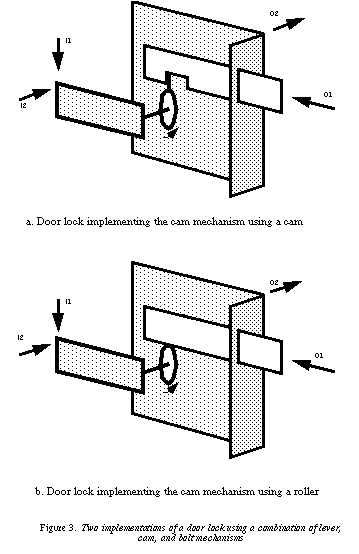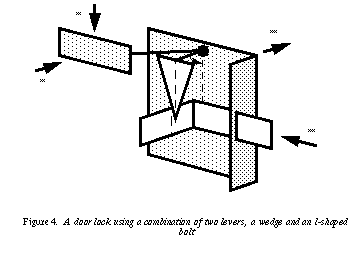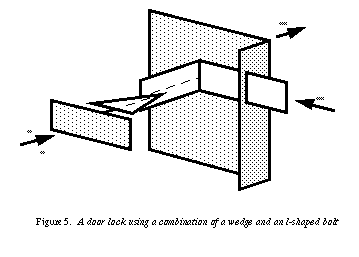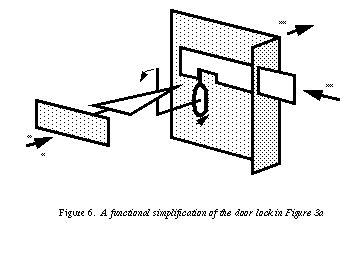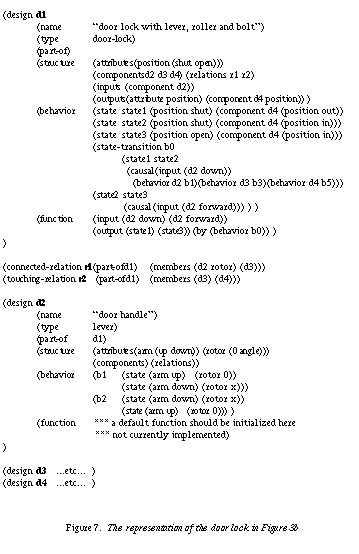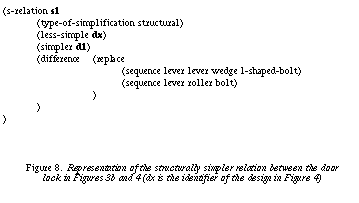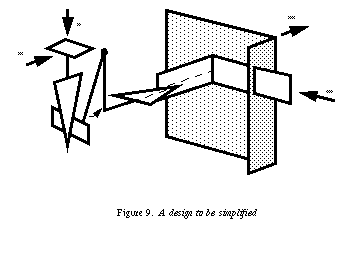Introduction
This research is concerned with the representations and reasoning required for Design Simplification. A design can be considered as simpler than another for a variety of reasons, such as shape, use, or ease of assembly, for example. Simplification, as a consequence, can be done with a variety of goals. In addition, simplification can be done in a variety of ways. For example, simplifications might be searched for (i.e., reasoned out) or retrieved (e.g., using CBR).
Our preliminary investigations are concerned with doing simplification by Analogy with stored simplifications.
The designs are represented as Function, plus Behavior, plus Structure. Structure is represented in terms of attributes, components and relations between components. Behavior is represented as state transition graphs, and causal chains. Function is represented as sets of inputs and outputs, with possible additional annotations about class of use, physical principles [Bhatta et al. 1994], or functional primitives [Keuneke 1991]. All simplifications are supposed to preserve the artifact's intended function.
Simplifications may be made at each of these levels, with possible consequences for the other levels of the representation. For example, simplifying the behavior may make a component redundant, leading to a structural change.
The propagation of changes across levels of representation (e.g., from behavior to structure) is, as far as we know, a new research area. The design simplification problem area in general raises many interesting research issues concerning functional reasoning and representations, and their interaction with analogical reasoning. In addition to the obvious benefits of any new research results, better understanding of the simplification of designs might eventually lead to the important consequence of cheaper, better designed products.
We do not know of any ongoing research in the area of "goal-based analogical reasoning for design simplification". However, there is certainly a rich body of research results in design simplification, functional reasoning, analogical reasoning in general, and purpose-directed analogical reasoning in particular.
A general approach to design simplification is Suh's [1990] "Reduction of the Information Content of a Product". This approach is described at a high level of abstraction and needs expert knowledge to apply it. However, we do intend to use some ideas presented in this work and also to compare the results of our investigations and experiments to the theories and results described by Suh. The Design For X (where X = Manufacturing, Assembly, Recycling, etc.) research community define clear principles and methods for reducing the life-cycle costs of a product [Boothroyd & Dewhurst 1991]. We will use those principles and methods in testing and evaluating our final design simplification system. Reasoning about designs from different points of view (view-point-based abstraction) is discussed by Manfaat [1997] [Manfaat et al 1996]. We apply ideas similar to those described in their work for performing simplification from different points of view
The main results in the domain of functional reasoning refer to defining functional representation schemes [Sembugamoorthy & Chandrasekaran 1986] [Chandrasekaran 1994] [Goel 1992] [Umeda & Tomiyama 1994] [Chittaro et al. 1993] , reasoning about function [Thadami & Chandrasekaran 1993] and applications of functional reasoning, such as conceptual design [Umeda & Tomiyama 1994], diagnosis [Chittaro 1995], and blame assignment [Stroulia & Goel 1995]. In this research we use a representation of and reasoning about designs rooted in the FR functional representation formalism [Chandrasekaran 1994]. From the point of view of functional reasoning our work can be viewed as a new application.
The main directions of research in analogical reasoning are the study of analogical reasoning as a cognitive process and as one of the main ingredients of creativity [Boden 1994] [Holyoak and Thagard 1995] [Finke et al. 1992]. The literature defines two types of analogical reasoning: transformational and derivational. [Gentner 1993] [Falkenheimer et al. 1993] [Carbonell 1993]. Simplification by analogical reasoning can be done either by transferring and adapting differences generated by a known simplification to the current problem (transformational), or by transferring and adapting an old simplification process to the new problem (derivational). While we currently only concentrate on the transformational approach, we plan to include derivational analogical reasoning into our final designs simplification system.
Finally, our research will further enrich the set of applications of analogical reasoning (learning [Carbonell 1993], planning [Veloso 1994], design [Qian & Gero 1992] [Bhatta & Goel 1994] [Bhatta et al.] [Goel 1997]). Of special interest for our work is the research in purpose-directed analogy. Our approach in using purpose (in this case simplification) to guide the different phases of the analogical reasoning was mainly inspired by [Kedar-Cabelli 1988].
Example Domain
To illustrate the concepts we are going to use, and to demonstrate our preliminary experimental results, we shall use examples from the domain of door lock designs [Chakrabarti & Tang 1996].
We consider a door lock to be a device that allows and prevents the opening of a closed door (or gate or window). It is composed of a box and a bolt which can be fully retracted into the box as a consequence of some input applied (Figure 1). When the bolt is completely retracted it allows the door (together with the whole lock) to move into the open position. Note that in order to simplify things we are only concerned here with the unlocking behavior of the lock.
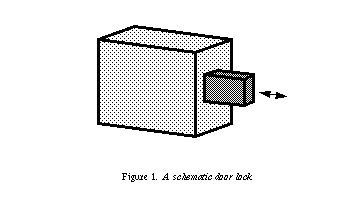
For our purposes, the behavior of the door lock is a three state process (Figure 2). The initial state corresponds to the closed door and is characterized by an unretracted bolt and a shut door. The second (intermediate) state is characterized by a retracted bolt and a shut door. The door lock may get into this state from the initial state as a consequence of applying some input. The final state corresponds to the open door and is characterized by a retracted bolt and an open door. This state can be reached from the intermediate state by applying a second input to the door lock.
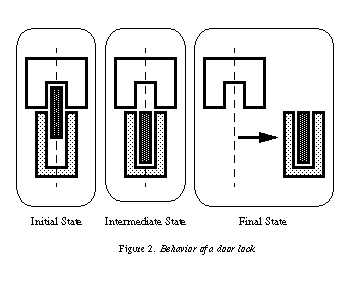
In our examples we shall limit ourselves to door locks implemented using simple components with distinct functional roles (such as levers, cams, shafts, etc.). We shall also assume that the inputs to a door lock will be forces characterized by their directions. Figures 3 through 5 present schematic examples of door locks.
